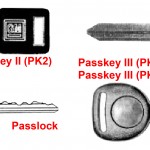Learn how to diagnose and fix a PassLock system
Diagnose and fix a PassLock system
This is one in a series of articles. READ THIS FIRST
GM made several different types of anti-theft systems. VATS, PassKey, and PassLock. The troubleshoot and reset procedures are different for each. PassLock seems to have the highest failure rate. So if you have a key WITHOUT a chip in it, chances are it’s a PassLock system. This article describes how to troublshoot and fix a PassLock system. But here are some more articles to help
Click here to see the resetting procedure for PassLock
Click here to see the trouble codes for a PassLock system
Click here to see a typical PassLock wiring diagram
IF you have a PassKEY system, click here to see the reset procedure
GM anti-theft systems, vehicle theft deterrent, passkey, passlock, VATS, how they work, how to fix, and how to reset.
GM has four generations of anti-theft systems. Here’s a brief description of each and how they work.
Vehicle Anti-Theft System (VATS)
VATS uses a Theft Deterrent Module (TDM) and a resistive pellet in the key. It reads the value from the resistor chip in the user’s key. If the resistance value matches what’s programmed into the TDS, the TDS sends a signal to the PCM that it’s a valid key and the user can then start the car. Lost or broken keys must be replaced with a key of the same resistive value. Get a key made at the dealer or a qualified locksmith. This system does not need to be reset if the PCM is replaced.
Passkey
This system also uses a Theft Deterrent Module (TDM). If the resistance value matches what’s programmed into the TDS, the TDS sends a signal to the PCM that it’s a valid key and the user can then start the car. Lost or broken keys must be replaced with a key of the same resistive value. Get a key made at the dealer or a qualified locksmith. This system does not need to be reset if the PCM is replaced.
Passkey II
This system also has a Theft Deterrent Module (TDM) but it’s programmed in to the body control module (BCM). If the resistance value matches what’s programmed into the BCM, the BCM sends a digital message to the PCM that it’s a valid key and the user can then start the car. Lost or broken keys must be replaced with a key of the same resistive value. Get a key made at the dealer or a qualified locksmith. There is a relearn procedure for this vehicle. Click HERE to see it.
Passlock
This system uses a coded lock cylinder. That’s right, the coding is built into the lock so if a thief pulls the lock cylinder they’ll never be able to start the vehicle. When you insert the proper key and turn the cylinder, a magnet on the cylinder induces a magnetic field onto a sensor. The sensor signal is read by either the instrument panel cluster (IPC) or the body control module (BCM) depending on the vintage of the vehicle. The Passlock system has a fairly high failure rate and I’ve listed instructions on how to fix it here. After repairing, click here to read how to reset the system.
Passkey III
This newest system uses a transponder key. An exciter coil located inside the ignition lock cylinder induces power into the transponder when the ignition switch is turned on. The transponder emits a unique signature signal that’s received by the Theft Deterrent Module (TDM). If the signature message matches what’s programmed into the TDM, the TDM sends a digital message to the PCM that it’s a valid key and the user can then start the car. Once you’ve repaired the system, you can reset it. Here’s the reset procedure.

Click to enlarge
© 2012 Rick Muscoplat
Posted on by Rick Muscoplat
